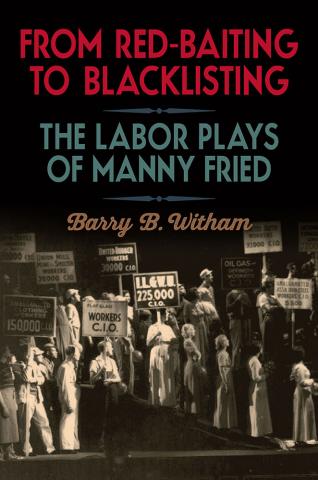By SIU Press
“Barry B. Witham reclaims the work of Manny Fried, an essential American playwright so thoroughly blacklisted after he defied the House Committee on Un-American Activities in 1954, and again in 1964, that his work all but completely disappeared from the canon,” the SIU Press says.
“Witham details Manny Fried’s work inside and outside the theatre and examines his three major labor plays and the political climate that both nurtured and disparaged their productions.
“Drawing on never-before-published interview materials, Witham reveals the details of how the United States government worked to ruin Fried’s career.”

“From Red-Baiting to Blacklisting includes the complete text of Fried’s major labor plays, all long out of print. In ‘Elegy for Stanley Gorski,’ Fried depicts one of the many red-baiting campaigns that threatened countless unions in the wake of the Taft-Hartley Act and the collusion of the Catholic Church with these activities. In ‘Drop Hammer,’ Fried tackles the issues of union dues, misappropriation, and potential criminal activities. In the third play, ‘The Dodo Bird,’ perhaps his most popular, Fried achieves a remarkable character study of a man outsourced from his job by technology and plant closures.”
–
From Wikipedia:
“Born in New York City to a working-class background, Fried married into a prominent upper-class Buffalo family. At the onset of World War II, Fried worked for Curtiss Aeroplane and Motor Company. There, Fried became involved in the company’s union, and was fired for subversive activities. From 1944-1946, Fried served in the US Army. After the war, Fried again worked as a labor organizer, and was fired after an FBI investigation into Communist ties.”
–
See also:
“Remembering Manny Fried,” from The Buffalo News via The Nation:
“Manny Fried, the actor, union organizer and prolific playwright who stood up to McCarthyism and served as an outspoken champion of the working class, died early Friday morning in a Kenmore nursing home. He was 97.
“Even until this year, he remained a guiding presence in Buffalo’s theater, literary and social activist communities and was widely regarded as the most important figure on Buffalo’s theater scene.”
–
Throwback to one of my favorite stories from 2012, on the FBI’s campaign against Buffalo artists Milton Rogovin and Manny Fried. https://t.co/FLg4FF8y8y pic.twitter.com/YacrRUlauh
— Colin Dabkowski (@colindabkowski) February 10, 2019
–
Manny Fried’s “The Un-American,” set to open at Subversive, explores the toughest decision of his life: http://t.co/0G8mseKKDh
— Colin Dabkowski (@colindabkowski) April 26, 2015
–
My uncle Manny Fried, a playwright/actor who was blacklisted for 30 years after telling HUAC what they could do with their questions, started a new production company when he was 93 … this has always been an inspiration to me, much as this story is inspiring.
— UpRise.org (@UpRiseDotOrg) August 20, 2018
Posted on May 12, 2020


